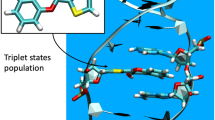Abstract
The singlet state of stilbene-4,4′-dicarboxamide can serve as a fluorescent probe of both DNA conformation and electron transfer. Covalent incorporation of the stilbene-dicarboxamide into DNA structures with restricted conformational mobility results in inhibition of stilbene isomerization and an increase in its fluorescence quantum yield and lifetime. The fluorescence of stilbenedicarboxamide is selectively quenched by proximate guanine, but not by the three other DNA nucleobases. Selective quenching occurs via an electron transfer mechanism in which stilbene serves as the electron acceptor and guanine as the electron donor. Kinetic analysis of the distance dependence of electron transfer in stilbene-bridged hairpins suggests that duplex DNA is more effective than proteins as a medium for electron transfer, but that it does not function as a molecular wire.
Similar content being viewed by others
Author information
Authors and Affiliations
Additional information
Received, accepted: 5 January 1998
Rights and permissions
About this article
Cite this article
Lewis, F., Letsinger, R. Distance-dependent photoinduced electron transfer in synthetic single-strand and hairpin DNA. JBIC 3, 215–221 (1998). https://doi.org/10.1007/s007750050224
Issue Date:
DOI: https://doi.org/10.1007/s007750050224




